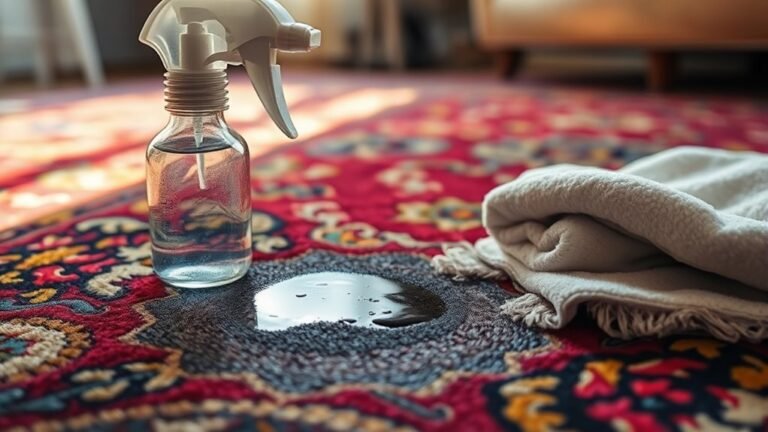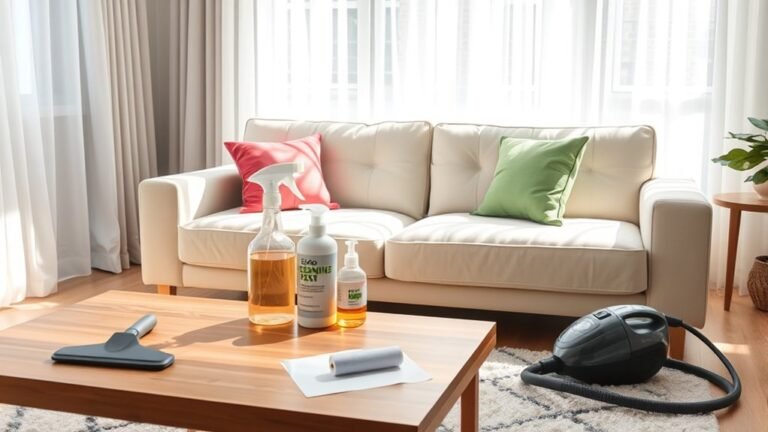Tips for Cleaning and Protecting Wooden Furniture
You’ll want to use gentle, plant-based cleaners and avoid harsh chemicals to keep your wooden furniture looking great. Dust regularly with a soft cloth, always following the grain. For sticky residue or stains, mild soap and warm water work well, but test first. Polish and condition wood every few months to maintain its shine and nourishment. Protect your furniture from moisture, heat, and sunlight to prevent damage. Keep these habits up, and you’ll maintain its beauty and durability over time.
Choosing the Right Cleaning Products for Wood

Although it might seem simple, choosing the right cleaning products for wood is essential to preserving your furniture’s finish and longevity. You don’t have to rely on harsh chemicals that can strip away the natural beauty of your pieces. Instead, opt for natural cleaners that protect and nourish the wood while giving you peace of mind. Chemical alternatives might promise quick results, but they often come with hidden risks, like damaging the finish or causing buildup. By selecting gentle, plant-based solutions, you maintain both the integrity of your furniture and your freedom to create a healthy living space. Remember, the right product respects the wood’s surface and supports the lasting charm you want in your home. Your furniture deserves care that’s as pure as your lifestyle.
How to Dust Wooden Furniture Properly
Dusting wooden furniture properly is one of the simplest yet most effective ways to keep your pieces looking their best. To do this right, choose the right dusting tools—microfiber cloths or soft, natural-bristle brushes work wonders. Avoid rough materials that can scratch the wood’s surface. When dusting, use gentle dusting techniques: move with the grain of the wood and apply light pressure to lift dust without damaging the finish. Regular dusting prevents buildup that can dull and degrade your furniture. For hard-to-reach spots, a soft brush or a vacuum with a brush attachment can help. By mastering these dusting techniques and using the proper dusting tools, you’ll preserve your wooden furniture’s natural beauty and enjoy a cleaner, freer living space.
Removing Stains and Sticky Residue Safely

Keeping your wooden furniture free of dust is a great start, but stains and sticky residue can still mar its surface. For effective stain removal, start by gently blotting the area with a damp cloth—avoid rubbing, which can spread the stain or damage the finish. If sticky residue is present, mix a mild solution of dish soap and warm water, then lightly apply it using a soft cloth. Always test any cleaner on an inconspicuous spot first to confirm it won’t harm the wood. Avoid harsh chemicals that strip protective coatings. After cleaning, dry the surface immediately with a clean, dry cloth to prevent water damage. Taking these careful steps lets you maintain your furniture’s natural beauty while enjoying the freedom of a clean, stain-free space.
Polishing and Conditioning Wood Surfaces
To keep your wooden furniture looking its best, you’ll want to choose the right polish that suits the wood type. Applying it correctly and knowing how often to condition your pieces can make a big difference in maintaining their shine and durability. Let’s explore these key steps to help your wood surfaces stay vibrant and protected.
Choosing the Right Polish
Although choosing the right polish might seem straightforward, it’s essential to pick one that suits your wood’s finish and condition. You want a product that enhances the natural beauty without causing damage. Natural oils like lemon or tung oil nourish the wood and bring out rich tones, perfect if you prefer an eco-friendly, subtle shine. On the other hand, commercial products often contain synthetic ingredients designed for quick results and durability, ideal if you want long-lasting protection with minimal effort. Consider how your furniture is used and the look you want to maintain. Avoid harsh chemicals that strip the finish. By selecting the right polish, you keep your wooden pieces vibrant and protected while enjoying the freedom to care for your furniture your way.
Application Techniques
When applying polish or conditioner, you’ll want to work with clean, dry surfaces to guarantee the product penetrates evenly and effectively. Proper surface preparation is key to achieving a lasting shine and protection. Use a soft cloth to apply the product in gentle, circular motions, following the wood grain to avoid streaks. Don’t rush—allow the product to absorb before buffing for a smooth finish.
| Step | Action | Tip |
|---|---|---|
| 1. Surface Prep | Clean & dry thoroughly | Use mild cleaner, dry well |
| 2. Application | Apply with soft cloth | Follow wood grain |
| 3. Absorption Time | Let sit for several min | Enhances penetration |
| 4. Buffing | Buff with clean cloth | Reveals natural shine |
Mastering these application techniques keeps your wooden furniture looking free and fresh.
Frequency of Conditioning
Once you’ve mastered the right way to apply polish or conditioner, it’s important to know how often your wooden furniture needs this care. The conditioning frequency largely depends on the wood type and your environment. Generally, conditioning every three to six months is enough to keep surfaces nourished and protected. However, you should adjust this based on seasonal upkeep—wood tends to dry out more in winter when indoor heating is on, so a little extra conditioning then helps maintain flexibility and shine. In humid summers, less frequent conditioning might be better to avoid buildup. Pay attention to your furniture’s feel and appearance; if it looks dull or feels rough, it’s time to condition. Trust your judgment and let seasonal changes guide your routine for the best freedom in care.
Protecting Wood From Moisture and Water Damage
To keep your wooden furniture safe from moisture, start by sealing it with a waterproof finish. This protective layer helps prevent water from soaking into the wood. Also, using coasters can stop water rings and spills from causing damage.
Seal With Waterproof Finish
Although wooden furniture can add warmth and charm to any space, it’s vulnerable to moisture damage if not properly sealed. To keep your furniture looking great and free from water stains, you need to apply a waterproof finish. Using waterproof sealants during finish application creates a strong barrier against spills and humidity. This protection lets you enjoy your furniture without constantly worrying about damage. When sealing your wood, remember to:
- Choose the right waterproof sealant for your furniture type
- Apply thin, even coats for better absorption
- Allow sufficient drying time between coats
- Sand lightly between applications for smoothness
- Reapply regularly to maintain protection
Sealing your wood empowers you to live freely without compromising your furniture’s beauty or durability.
Use Protective Coasters
While sealing your wooden furniture offers essential protection, using protective coasters is a simple yet effective way to prevent moisture rings and water damage. You’ve got plenty of freedom to choose coaster materials that fit your style—whether it’s natural cork, absorbent ceramic, or sleek silicone. Each material offers unique benefits, like cork’s eco-friendly vibe or ceramic’s easy cleanup. Don’t overlook coaster designs either; from minimalist to bold patterns, the right design can complement your furniture and personal taste. By consistently placing drinks on coasters, you shield your wood from harmful moisture and stains. It’s a small habit that preserves your furniture’s beauty and gives you peace of mind, letting you enjoy your space without worrying about water damage.
Preventing Sunlight and Heat Damage

Since wooden furniture is sensitive to extreme temperatures and direct sunlight, you’ll want to protect it from these elements to maintain its appearance and durability. Exposure to harsh sunlight can cause fading and cracks, while heat can warp the wood. To keep your furniture looking free and fresh, consider these tips:
- Install sunlight filters like sheer curtains or UV-protective window films to reduce direct rays.
- Use heat shields or pads under hot objects to prevent surface damage.
- Position furniture away from radiators, vents, or fireplaces to avoid heat exposure.
- Rotate furniture occasionally to guarantee even exposure and prevent uneven fading.
- Keep blinds or shades closed during peak sunlight hours for added protection.
Tips for Long-Term Maintenance and Care
To keep your wooden furniture looking its best over time, you’ll need to establish a regular maintenance routine that goes beyond just cleaning. This commitment guarantees wooden furniture longevity and lets you enjoy its natural beauty without worry. Here’s a simple guide to help you stay on track:
| Task | Frequency |
|---|---|
| Dusting | Weekly |
| Polishing | Monthly |
| Inspecting for damage | Quarterly |
Remember to use gentle products and avoid harsh chemicals. Rotate cushions and furniture placement occasionally to prevent uneven wear and sun exposure. By embracing these maintenance routines, you free yourself from constant repairs and keep your furniture thriving for years, letting you relax and enjoy your space without constraints.
Frequently Asked Questions
Can Wooden Furniture Be Cleaned With Vinegar and Water?
You might feel like a modern-day alchemist mixing simple ingredients to create magic. Yes, you can clean wooden furniture with vinegar and water, enjoying vinegar benefits like natural antibacterial properties and a streak-free finish. It’s a great cleaning alternative if you want to avoid harsh chemicals and embrace freedom from synthetic cleaners. Just remember to dilute vinegar properly and test on a small area first to keep your wood safe and shining.
How Often Should Wooden Furniture Be Refinished?
You’ll want to contemplate the refinishing frequency based on how much wear your wooden furniture gets. Generally, every 5 to 10 years is a good rule of thumb for wood care. But if your piece faces heavy use or outdoor exposure, you might need to refinish more often. Keep an eye out for dullness, scratches, or water damage. By staying on top of it, you’ll keep your furniture looking fresh and free to enjoy!
Are There Specific Woods That Require Special Cleaning Methods?
Yes, you’ll find that hardwood care and softwood maintenance differ quite a bit. Hardwoods like oak or maple usually need gentle cleaning with a damp cloth and occasional polishing to keep their shine. Softwoods, such as pine or cedar, are more sensitive and can require milder cleaners and extra protection from moisture. Knowing these differences lets you care for your furniture freely, keeping each piece looking great without stressing over the wrong cleaning methods.
Can Wooden Furniture Attract Pests, and How to Prevent It?
You might wonder if wooden furniture really attracts pests. The truth is, it can, especially if the wood’s untreated or has cracks where insects like termites hide. To enjoy your furniture pest-free, you’ll want to focus on pest prevention by using proper wood treatments like sealants or oils. These not only protect the wood but keep bugs away, letting you relax and enjoy your space without worrying about unwanted guests.
Is It Safe to Use Commercial Furniture Wipes on Antique Wood?
You might want to be cautious using commercial furniture wipes on antique wood. While they’re convenient, they often contain chemicals that can harm delicate finishes, risking antique preservation. Instead, opt for gentle, pH-neutral solutions or specialized products made for antiques to maintain the wood’s character. Remember, effective furniture maintenance is about preserving freedom to enjoy your pieces for years, not just quick fixes that could cause long-term damage.






